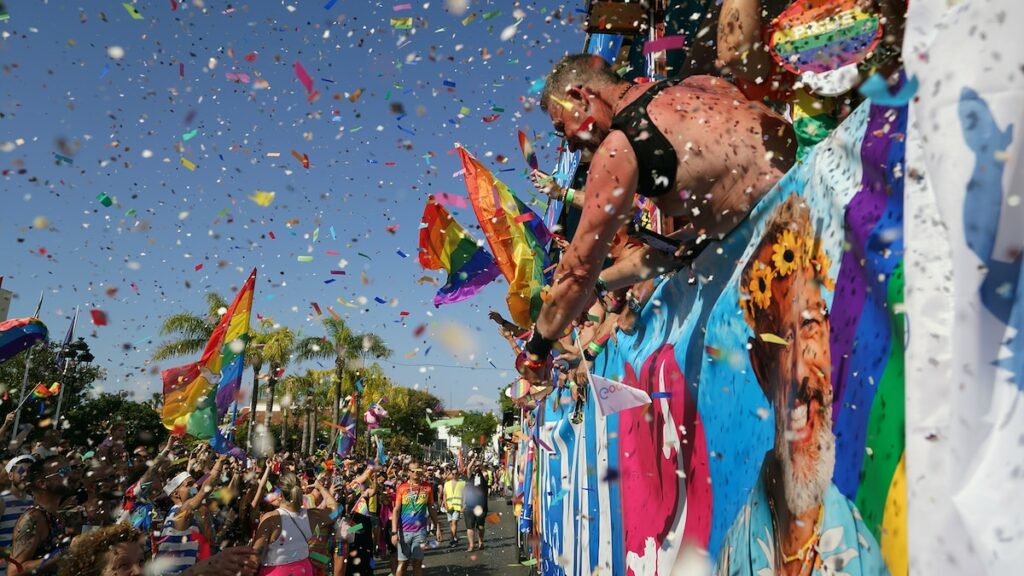The iconic rainbow Pride flag, often seen adorning homes, businesses, and car bumpers worldwide, is much more than a colorful display. It stands as a vibrant testament to LGBTQIA+ pride, a symbol of safe spaces, and an emblem of unwavering support.
“The LGBTQ+ community exists everywhere—exemplified by the rainbow,” says Robert Kesten, executive director of the Stonewall Museum.
When was the rainbow flag first waved?
In preparation for the San Francisco Gay and Lesbian Freedom Day Parade on June 25, 1978, California’s first openly gay elected official, Harvey Milk, commissioned Gilbert Baker—an openly gay veteran, drag queen, activist, and artist—to create a symbol representing the LGBTQIA+ community.
Gilbert Baker, the artist behind the Rainbow Flag, crafts one of the 500 Pride flags featured in a 1998 installation for the Gay Rights Project.
Photograph Jerry Telfer/San Francisco Chronicle via Getty Images
Baker’s eight-colored rainbow-striped flag, which he felt expressed the LGBTQIA+ community’s joy, beauty, and power, was inspired by the American flag. “In the late 1970s, national pride was at a peak because of the bicentennial, and homophobia was rife in U.S. society. Using national symbols for queer pride resonated with many queer people,” says Christopher Ewing, assistant professor of history at Purdue University.
Dozens of parade-goers show off their Pride flags during Nantes for Pride in Nantes, France.
Photograph By Jeremie Lusseau / Hans Lucas/Redux (Top) (Left) and Photograph By The New York Times/Redux (Bottom) (Right)
The original configuration included pink to signify sex; red, life; orange, healing; yellow, sunlight; green, nature; turquoise, magic; blue, harmony; and purple, spirit. After the assassination of Harvey Milk in November 1978, demand for the flag increased, leading to the removal of the pink and turquoise stripes due to manufacturing constraints. The six remaining rainbow colors then became the enduring symbol of gay pride.
(From LGBT to LGBTQIA+: The evolving recognition of identity.)
How the rainbow flag became more inclusive
Baker’s rainbow flag has been updated many times to be more inclusive. “The evolution of the rainbow flag reflects how the queer community continues to grapple with issues of race and gender. Recent iterations of the flag center queer BIPOC and gender nonconforming people who face discrimination in queer spaces,” says Cookie Woolner, associate professor of history at the University of Memphis.
A crowd displays a vibrant Rainbow banner during the Pride parade in Mexico City.
Photograph By ALFREDO ESTRELLA/AFP via Getty Images
In 2017, the Philly Pride flag was unveiled at Philadelphia City Hall, created by Philadelphia’s Office of LGBT Affairs under the leadership of Amber Hikes. This version features black and brown stripes at the top to include the QTBIPOC (Queer, Trans*, Black, Indigenous People of Color) community that has historically been excluded from queer movements despite facing prejudice and violence as double minorities.
The Philadelphia Pride flag, a modified version of the traditional rainbow flag, features two additional stripes—black and brown—at the top. It aims to represent and honor LGBTQIA+ people of color within the community.
Photograph By Matt Slocum/AP
“The involvement of QTBIPOC was central to the Stonewall rebellion. These additions pay homage to them and center them,” says Rebekkah Mulholland, assistant professor of history at CSU Sacramento.
In 2018, the rainbow emblem was updated by nonbinary artist Daniel Quasar to include the white, pale pink, and blue stripes of the trans* pride flag, symbolizing a commitment to greater inclusivity. “The Progress Pride flag is about resisting the erasure of QTBIPOC within the movement,” Ewing says. “It reincorporates pink, one of the original colors that was jettisoned in a new context.”
(How rural queer communities connect through storytelling.)
The black and brown stripes form a chevron shape filled with the light blue, pink, and white colors of the trans* flag. “It’s important to center trans* people because they’ve often been on the front lines of activism and faced the most repercussions due to their often-visible gender transgression,” Woolner says.
In 2020, a new LGBTQIA+ rainbow pride flag emerged—The Queer People of Color flag. Although the designer remains unknown, the banner highlights queer and racial equity by incorporating the Black Lives Matter motif of a raised fist in a gradient of skin tones. Ewing says that the “political movement that led to the creation of the rainbow flag in the late 1970s is unimaginable without the contributions of QTBIPOC” and that centering QTBIPOC “asserts the unmovable place of people of color in the LGBTQIA+ movement.”
The Intersex-Inclusive Pride flag, a variation of the traditional rainbow Pride flag, features a yellow triangle with a purple circle placed in the center. It is the most recent iteration of the Pride flag.
Photograph By Elliott Franks/Eyevine/Redux
The most recent iteration of the pride flag, the Intersex-Inclusive Pride Progress flag, was crafted in 2021 by Valentino Vecchietti, an intersex columnist and media personality. “Pride flags exist not to contain or delineate us, but to reflect our diverse existence and to create inclusive visibility,” she says. “Inclusion cannot be assumed; it matters that we can see it.” The flag builds upon the Progress Pride design by incorporating a purple circle within a yellow triangle, symbolizing intersex pride. With 11 colors, it’s a subtle nod to the original rainbow pride emblem.
(See this photographer documents her own gender transition.)
Baker’s flag has undergone numerous revisions — and will likely continue to be reimagined. “The more we see how broad the spectrum of human identity is, the more iterations of the flag will be,” Kesten says. “In a community as vibrant, creative, and [engaged in activism] as this one, the flag will continue to evolve.”
>>> Read full article>>>
Copyright for syndicated content belongs to the linked Source : National Geographic – https://www.nationalgeographic.com/history/article/history-of-the-lgbtqia-pride-flag
